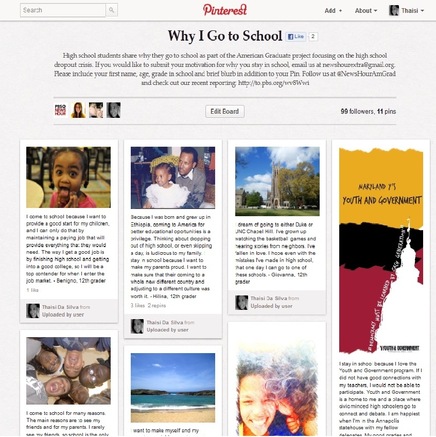Why I go to school: A student multimedia project – Lesson Plan

Subject(s)
Journalism, Art, English, Social Studies
Estimated Time:
45 to 60 minutes
Grade Level
Grades 7-12
Objective
Students will brainstorm why they go to school every day and choose a photo to represent their idea. Then, they will write three to four sentences about their motivation to go to school, while building key multimedia and writing skills.
Overview
Pinterest is an online social media platform that encourages users to view, share and display photos and ideas on virtual “pinboards.” This lesson plan will use Pinterest to have students think in-depth about what keeps them in school.

Background
The high school dropout crisis is affecting many American schools, and experts are hard at work trying to find out why kids drop out. The American Graduate initiative and the PBS NewsHour are also reporting on what’s behind the nation’s dropout crisis. To look at the issue from another angle, this lesson plan addresses a elated question: what motivates kids to stay in school?
Procedure
- Have the class watch this video from a NewsHour Extra producer about how the process will work and why this project is important.[youtube http://www.youtube.com/watch?v=3J5m6tUXVPk]
- Give students a few minutes to think about why they come to school every day and how they might represent that idea visually. Have them look at what’s already on the NewsHour’s Pinterest board for examples.
- Have each student sit at a computer and find a photo that represents their idea. They may use personal photos or find fair-use photos on the Web from sources like Flickr, Google Images or Wikimedia Commons. Have students find and save a photo credit to send with their photo that states where it came from. Here are some resources for fair-use photos:
- Flickr Creative Commons
- Google Advanced Image Search – be sure to select “only images labeled for reuse.”
- Wikimedia Commons
If students choose to submit a personal photo, please let them know that Pinterest reserves the right to use and even sell the photo as they see fit.
- Once students have selected their photos, ask them to write three to four sentences explaining why what’s pictured in the photo motivates them to go to school. Again, see the NewsHour’s Pinterest board for examples. Please note that Pinterest limits photo descriptions to 500 words.
- Have students e-mail their completed posts (image URL or image as an attachment with photo credit, three to four sentence description, first name, grade, school, city/state) to newshourextra [at] gmail.com.Make sure they put “Pinterest” in the subject line! We’ll post them to our Pinterest page, and students will be able to see their work online.
Extension Activity
With your class, watch these Student Reporting Labs videos chronicling young people who overcame unique challenges on the Road to Graduation. Homelessness, illness and problems at home almost caused these teens to drop out, but in the end — they persevered.
Have the class discuss which parts of the video most resonated with them, which they most agree with and disagree with, and why. Is dropping out a problem in their school? Why or why not? Are there programs in place at your school to help teens overcome obstacles?
Classrooms interested in making their own short videos about overcoming challenges on the path to graduation can visit www.studentreportinglabs.com and use the free curriculum to get started. Please e-mail lclapman [at] newshour.org if you decide to make a video or are interested in the Student Reporting Labs program.
Source: Headline News